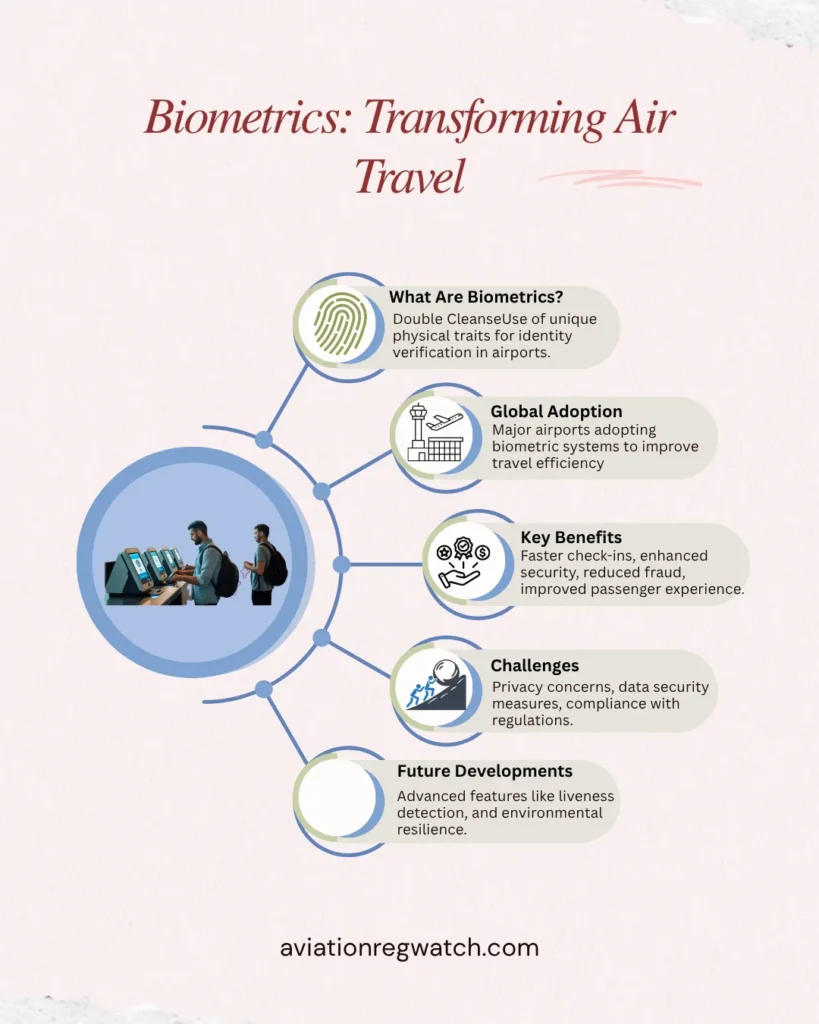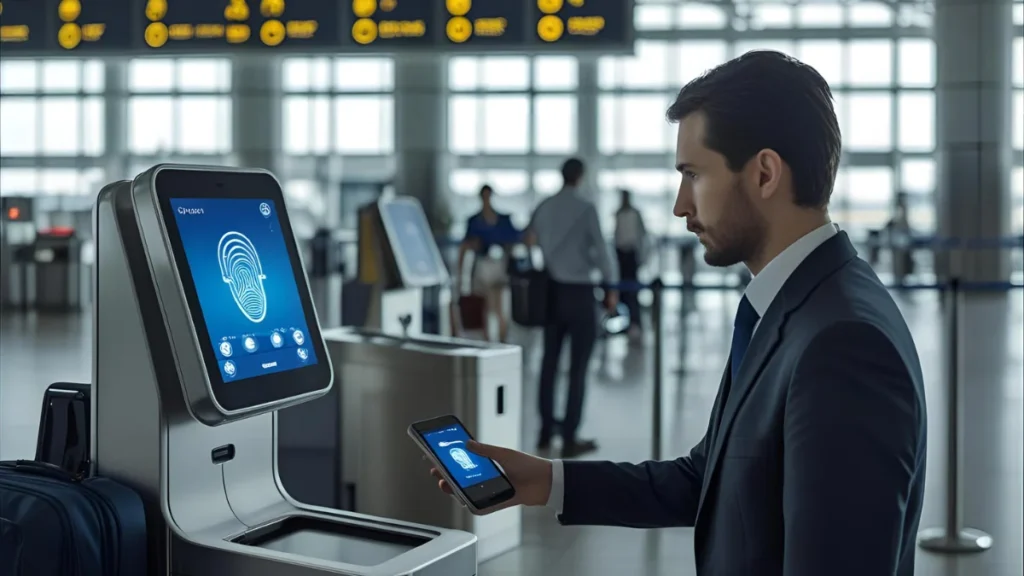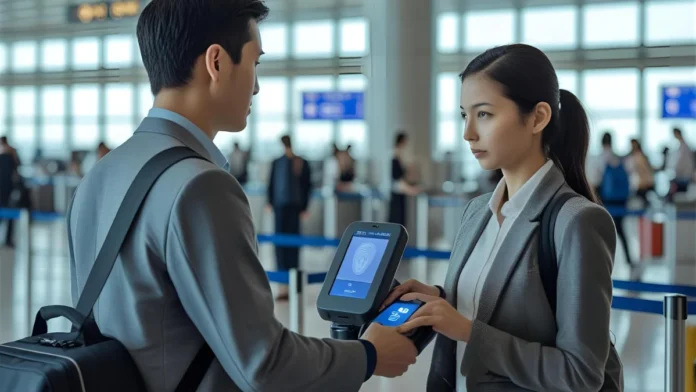Discover how biometrics in air travel enhance security, speed up processes, and provide a seamless passenger experience at airports worldwide.Biometric technology is changing air travel for the better. By 2024, approximately 46% of travelers will have used biometric systems at airports. A whopping 73% of them preferred biometrics over old-school documents like passports.
Biometrics in air travel- tech uses facial recognition, fingerprint scanning, and iris recognition. It’s key to making airport procedures smoother and safer.
The Role of Biometrics in Airports
Biometric technology is changing how we check identities at airports. It makes every step of travel easier.
Biometrics in air travel: How Biometrics Work
- What It Replaces: Biometric tech means no more showing passports or boarding passes at every checkpoint. This makes travel smoother and more convenient, from check-in to boarding.
- How It Works: It uses advanced facial recognition to scan and match passengers’ faces. This happens in seconds, cutting down wait times and making airports more efficient.
- Security Boost: Biometric Systems Make Airports Safer. They use unique facial features to prevent identity fraud. This makes it hard for fake IDs to fool the system, making security checks more reliable.
Global Roll-Out of Biometric Technology
Biometric systems are being implemented worldwide. Here’s a look at some major airports and their plans:
| Airport | Status by 2025/2026 |
| Singapore Changi | 95% of immigration will be automated, with clears taking 10 seconds. |
| Dubai International | Smart gates will be available at security, immigration, and boarding. |
| Abu Dhabi Zayed International | Full biometric deployment planned at all security checkpoints by 2025. |
| King Salman International (Saudi) | Biometric systems will be integrated into new airport designs. |
Enhancing the Passenger Journey
Biometrics in air travel: Booking & Pre-Travel
- Digital Travel ID Setup: Passengers must use their airline’s app or website to set up their Digital Travel ID. They need to take a selfie and scan their passport. The selfie verifies their identity, and the passport scan provides essential details.
- Outcome: After submitting the data, it undergoes a secure verification check. This confirms the passenger’s identity and links it to their flight, making check-in smoother and safer.
Online Check-In
- Process: Passengers can use a selfie to check in, skipping the need to enter passport info. This uses facial recognition for secure identification.
- Lufthansa has introduced a new method for check-in, allowing passengers to take selfies, which cuts down wait times and improves efficiency. This method speeds up check-in and enhances security, making air travel more convenient and secure.
Airport Check-In Kiosks
New technologies, such as facial recognition and gesture control, are changing how we use devices. It’s making touchscreens less necessary.
Tokyo’s Narita Airport is set to lead the way with new kiosks by early 2025. These kiosks will utilize advanced technology for easy identity verification. Travelers can print their boarding passes without needing to enter any information.
Facial recognition enables fast and accurate identity checks. This makes checking in easier and more efficient. It’s also making travel cleaner and more user-friendly.
Baggage Drop & Claim
Secure Linking:
Facial recognition at baggage drop points securely links luggage to its owner.
For example, Delhi’s Indira Gandhi International Airport is introducing biometric baggage checks. This will make dropping off and picking up bags easier and safer.
Minimizing baggage fraud:
Facial scans help airports fight baggage theft.
This technology ensures that only the intended recipient can claim their luggage. It reduces theft and mix-ups.
Security Screening
U.S. airports are utilizing facial recognition cameras to expedite travel.
These cameras compare a traveler’s face to the data on their passport or driver’s license.
This makes security checks faster and safer. It reduces physical contact and wait times.
Passengers get a quick identity check. This makes the security process smoother and safer.
Boarding
- Quick Boarding Process: Passengers can walk in and have their faces scanned, eliminating the need to present boarding passes.
- Adoption Rate: By mid-2024, it’s expected that 98% of airlines will adopt biometric methods for boarding.
Addressing Privacy and Data Security Concerns
Balancing Privacy with Convenience
Biometric tech in airports raises privacy concerns. Here’s how these are being handled:
- Data Protection Regulations: Biometric systems adhere to strict laws, such as the GDPR, to protect personal data. They only collect data with consent.
- Data Encryption: Sensitive info is encrypted to keep it safe. Airports store data securely and only allow authorized access.
- Limited Retention: Laws limit the retention period for biometric data. This prevents misuse or exposure.
Ensuring Accuracy and Preventing False Positives
Biometric systems must be accurate to keep airports running smoothly.
These systems use advanced algorithms for identity matching.
These algorithms learn from large datasets, getting better over time.
Airports regularly test and adjust their systems to ensure optimal performance.
This ensures the tech works well and catches any issues.
They also have backup plans for when biometric checks fail.
Trained staff can quickly switch to manual checks if needed.
Benefits of Biometric Systems in Airports
Biometric systems make traveling faster and safer. They help airports move people quickly and keep everyone safe. This means travelers can get to their gates without delays.
These systems also make sure everyone is accounted for. They do this without making travel slower or less safe.
By utilizing these systems, airports can maintain smooth travel, even during challenging times.
Cost Considerations: Balancing Investment and Benefits
Setting up biometric systems can be costly. However, it’s essential to consider the benefits for airports and travelers.
Initial Investment vs. Long-Term Savings
- Getting started with biometric systems can be costly upfront. This includes the costs of technology, training, and implementation.
- However, over time, these systems improve efficiency. This means airports can save money by reducing the need for frequent checks and by enabling staff to work more efficiently.
- Biometric systems also let airports handle more passengers. This means they can meet demand without needing to expand.
Value Proposition for Travelers
- Biometric methods make travel faster and safer. This makes the journey smoother and more enjoyable for everyone.
- Biometric systems also save airlines money. They reduced costs related to staffing, fraud prevention, and processing.
Top 5 Benefits of Airport Biometrics

- Enhanced Security
- Biometric checks provide consistent and reliable identity verification.
- Example: Australia plans to start using biometric passports by 2030 to prevent undocumented entries.
Faster Processing
- Biometric systems can match identities in under ten seconds. This is much faster than old methods.
- Evidence: The U.S. Global Entry program demonstrates how quickly biometric checks can be conducted.
Improved Experience
- Less paperwork and quicker processes mean less stress.
- Approximately 80% of U.S. travelers prefer biometrics for saving time and convenience.
Cost Efficiency
- Biometric systems can handle more passengers without needing more space or staff.
Fraud Prevention
- Systems like the European Union’s Entry/Exit System use biometrics to stop identity fraud during every visit.
Challenges and Considerations
Data Security
Cyber Threats:
Keeping biometric databases secure is crucial. This is because biometric data, like fingerprints and facial recognition, is unique.
If these databases get hacked, it’s severe. This is because biometric data can’t be changed like passwords. Once it’s stolen, it’s always at risk of being used for identity theft and fraud.
Unlike passwords, biometric data can’t be changed. This makes it hard to protect personal identity.
Defensive Measures:
To combat these threats, airports require robust defenses for biometric data.
They should use strong encryption to keep data safe both during transmission and storage, thereby preventing unauthorized access to sensitive information. Additionally, utilizing secure storage, such as hardware security modules (HSMs), can safeguard biometric data against both physical and cyber threats.
Additionally, airports should have plans in place for addressing data breaches. These plans should outline the procedures for identifying, mitigating, and resolving breaches. Training staff to respond promptly to breaches is crucial for maintaining data security.
Looking Ahead: System Capabilities

As biometric systems evolve, new features are being introduced:
- Seamless Ecosystem: Integrated technologies across kiosks, applications, and border control systems ensure a cohesive process.
- Liveness Detection: New features prevent spoofing attempts.
- Matching Modes: The technology supports both one-to-one (identity verification) and one-to-many (database checks) matching.
- Attribute Analysis: Systems can analyze age, expressions, and accessories.
- Environmental Resilience: Reliable performance across different lighting situations.
- Global Usability: Support for over 30 languages to cater to diverse travellers.
Biometrics in Air Travel: Conclusion
Biometric technology is now a key part of airports, moving from testing to everyday use. Bio metrics in airtravel makes travel smoother by speeding up check-in, baggage handling, and boarding. Airports can handle more people, and airlines save money.
But, using biometrics means we must protect privacy and keep data secure. As these systems expand, we need to ensure they’re safe and respect our rights. Biometrics in air travel promise a better travel experience for all.
Biometrics in Air Travel: FAQs
1. What are biometrics in air travel?
Biometrics refers to using physical characteristics, like your face or fingerprints, to confirm your identity at various airport processes.
2. How do facial recognition systems work?
Facial recognition matches unique features of your face with images stored in identities like passports within seconds to verify if they match.
3. Are biometric systems safe to use?
Yes, they enhance security and reduce fraud while also requiring strict encryption and data protection measures to protect your information.
4. What benefits do biometric systems offer?
They provide faster processing, enhanced security, increased convenience for travellers, and lower operational costs for airports.
5. How widely are biometrics being adopted?
Biometric technology is being rolled out in major airports worldwide, with many airlines planning to implement it fully by mid-2024.
Source: ICAO

